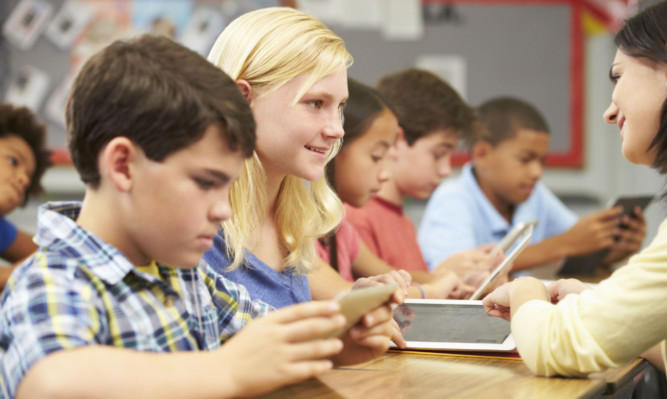As a Dundee school becomes one of the first in Scotland to integrate iPads into the classroom, Gayle Ritchie asks: are books on their way out?
If they’re not tweeting on Twitter, posting selfies on Instagram or updating their Facebook statuses, the chances are young folk are doing something with their mobile devices. But it’s not all ice bucket challenges and celebrity gossip; the value of new technology in education has long been recognised and is now being integrated into classrooms in Courier Country.
Following a successful trial period, the use of iPads is now part of everyday learning and teaching in L6-F4 (P6-S4) at the Dundee High School, a move championed by Rector Dr John Halliday.
He reckons arming pupils with the devices equips them with skills they need to get ahead, and believes it’s the school’s “duty” to ensure they get the opportunity to embrace new technology.
“This technology is the most amazing tool to assist pupils in developing their sense of enterprise, excitement in learning, and their ability to flourish in an ever-changing, increasingly digital world,” he says.
“Computers in schools are standard this, however, takes this element of learning on to a whole new level, bringing a sharp focus on each pupil’s own responsibility for their own learning.
“It is a preparation for life, as digital literacy is already a given in so many areas of life beyond school, whether at university or in the workplace.
“Students are increasingly required to produce their work digitally and share it online. Similarly, public examinations are moving in the direction of online sitting and in many cases are already with us. To ignore this technology would be irresponsible in the extreme.”
While the iPads are being bought by parents, pupils who already own their own devices can bring them into school. And they’re fully embracing the opportunity to do so.
“We enjoy using iPads,” says L6 pupil Dominic Westwood. “They help you to learn and have made our schoolbags lighter! People use iPads in their jobs and at home so you have to be able to use the technology.”
F4 pupil Catriona Murphy says: “Instead of having to go to the library, you can access what you need quickly and then straight away, click back to your essay and incorporate what you have discovered. In music, we’ve been using a game which enables you to learn and recognise new chords.”
The technology is not there to replace writing and drawing by hand, or developing fine motor skills and physical development, stresses Dr Halliday: “It is not replacing the thrill of participation in music, drama or sport, of getting hands dirty on field work, or the excitement of a practical experiment in science.”
The school’s head of maths, John Mordente, believes iPads bring his subject to life. “We still use jotters but now we have access to applications which allow pupils to see visual results straight away.
“Work which might previously have involved an investigation which would take hours, is now much more readily accessible and because students can visually follow the results as they enter data, they get a real understanding of the concepts.”
So what’s going to happen to traditional methods of learning, like using notepads and textbooks? Are these becoming outmoded? Are images of boys carrying girls’ books (remember the romantic songs of the 1960s and 1970s?) and those of schoolkids struggling with heavy schoolbags packed full of books, gone forever?
Dr Geoffrey Lund, from Abertay University’s School of Science, Engineering and Technology, believes there’s great value in equipping pupils with mobile devices, although he doesn’t agree there’s no room for books in learning.
“Using iPads in the classroom gives students a totally different educational experience but it’s more about problem solving than learning facts,” he says.
“Devices like iPads are interactive and, of course, you can share information; they’re a great teaching tool. Yes, there are some good books, but often, they can be out of date as soon as they are printed.
“With a subject like maths, you only get so many examples in a book, whereas there really are no limits when it comes to computing; you can generate as many numbers as you wish.
“Whether you need books is subject dependent. With technical subjects you could do workshops on an iPad but with something like chemistry and biology, where there are quite complex coloured images, it might be easier to see text and diagrams in a book rather than on a screen.”
Professor Jon Rogers, chairman of Creative Technology at Duncan of Jordanstone College of Art, believes giving students tablets to support their work is a great idea in principle.
But he says getting their hands on technology is “only half of the digital literacy story”.
“To talk of digital literacy as being able to use digital technology is far from the reality of what is required in 21st century education,” he says.
“(It’s) great to give pupils the ability to learn from the web, but let’s get serious and give them the ability to write and change the web to take control of it and make it theirs to own. I’d love to see students in Dundee being connected into the city’s incredible digital heritage of creating gaming, applications and digital commerce.
“I’d invest in developing a curriculum for excellence that put creating not just consuming at the heart of their digital learning. Giving tablets to everyone in a school is a bit like giving books to everyone, but not having access to paper and pens.
“If we want to take the lead, I’d love to talk about how we can have students in Scotland learning to read, write and run applications that enable our society to grow into a truly digitally-literate world.”
